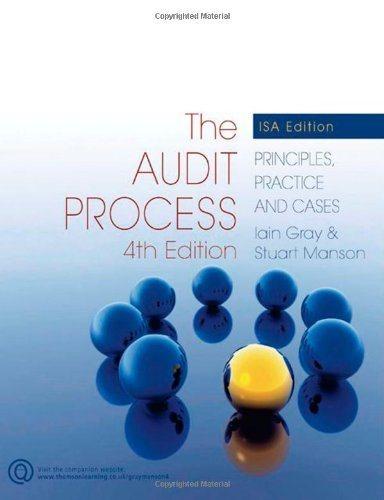Question
1) Bay City Companys fixed budget performance report for July follows. The $594,000 budgeted total expenses include $450,000 variable expenses and $144,000 fixed expenses. Actual
| 1) Bay City Companys fixed budget performance report for July follows. The $594,000 budgeted total expenses include $450,000 variable expenses and $144,000 fixed expenses. Actual expenses include $134,000 fixed expenses. |
| Fixed Budget | Actual Results | Variances | |||||||
| Sales (in units) | 8,100 | 7,000 | |||||||
|
| |||||||||
| Sales (in dollars) | $ | 648,000 | $ | 630,000 | $ | 18,000 | U | ||
| Total expenses | 594,000 | 559,000 | 35,000 | F | |||||
|
| |||||||||
| Income from operations | $ | 54,000 | $ | 71,000 | $ | 17,000 | U | ||
|
| |||||||||
| Prepare a flexible budget performance report that shows any variances between budgeted results and actual results. List fixed and variable expenses separately. |
2) [The following information applies to the questions displayed below.]
| Hart Company made 4,200 bookshelves using 36,000 board feet of wood costing $360,000. The company's direct materials standards for one bookshelf are 9 board feet of wood at $9.90 per board foot. |
Required information
| Hart Company records standard costs in its accounts and its materials variances in separate accounts when it assigns materials costs to the Work in Process Inventory account. |
| A) | Prepare the journal entry that both charges the direct materials costs to the Work in Process Inventory account and records the materials variances in their proper accounts. |
B) Assume that Hart's materials variances are the only variances accumulated in the accounting period and that they are immaterial. Prepare the adjusting journal entry to close the variance accounts at period-end.
3)
| After evaluating Null Companys manufacturing process, management decides to establish standards of 3 hours of direct labor per unit of product and $15.40 per hour for the labor rate. During October, the company uses 17,500 hours of direct labor at a $273,000 total cost to produce 6,000 units of product. In November, the company uses 22,400 hours of direct labor at a $351,680 total cost to produce 6,400 units of product. |
| A) | Compute the direct labor rate variance, the direct labor efficiency variance, and the total direct labor cost variance for each of these two months. 4) World Company expects to operate at 70% of its productive capacity of 23,000 units per month. At this planned level, the company expects to use 12,075 standard hours of direct labor. Overhead is allocated to products using a predetermined standard rate based on direct labor hours. At the 70% capacity level, the total budgeted cost includes $48,300 fixed overhead cost and $144,900 variable overhead cost. In the current month, the company incurred $197,750 actual overhead and 11,625 actual labor hours while producing 13,900 units. (Round "OH costs per DL hour" to 2 decimal places.)
| ||||||||||||||||||||||||||||||||||||||||||||||||||||||||||||||||||||||||||||||||||||||||||||||||||||||||||||||||||||||||||||
5)
| Trico Company set the following standard unit costs for its single product. |
|
| ||
| Direct materials (27 Ibs. @ $3 per Ib.) | $ | 81.00 |
| Direct labor (6 hrs. @ $6 per hr.) | 36.00 | |
| Factory overheadvariable (6 hrs. @ $4 per hr.) | 24.00 | |
| Factory overheadfixed (6 hrs. @ $5 per hr.) | 30.00 | |
|
| ||
| Total standard cost | $ | 171.00 |
|
| ||
| The predetermined overhead rate is based on a planned operating volume of 60% of the productive capacity of 70,000 units per quarter. The following flexible budget information is available. |
|
| Operating Levels | |||||
|
| ||||||
| 50% | 60% | 70% | ||||
| Production in units | 35,000 | 42,000 | 49,000 | |||
| Standard direct labor hours | 210,000 | 252,000 | 294,000 | |||
| Budgeted overhead | ||||||
| Fixed factory overhead | $ | 1,260,000 | $ | 1,260,000 | $ | 1,260,000 |
| Variable factory overhead | $ | 840,000 | $ | 1,008,000 | $ | 1,176,000 |
| During the current quarter, the company operated at 70% of capacity and produced 49,000 units of product; actual direct labor totaled 287,000 hours. Units produced were assigned the following standard costs: |
|
| ||
| Direct materials (1,323,000 Ibs. @ $3 per Ib.) | $ | 3,969,000 |
| Direct labor (294,000 hrs. @ $6 per hr.) | 1,764,000 | |
| Factory overhead (294,000 hrs. @ $9 per hr.) | 2,646,000 | |
|
| ||
| Total standard cost | $ | 8,379,000 |
|
| ||
| Actual costs incurred during the current quarter follow: |
|
| ||
| Direct materials (1,318,000 Ibs. @ $3.10 per lb.) | $ | 4,085,800 |
| Direct labor (287,000 hrs. @ $5.75 per hr.) | 1,650,250 | |
| Fixed factory overhead costs | 2,545,094 | |
| Variable factory overhead costs | 2,382,642 | |
|
| ||
| Total actual costs | $ | 10,663,786 |
|
| ||
A) Compute the direct materials cost variance, including its price and quantity variances.
B)Compute the direct labor variance, including its rate and efficiency variances.
C)Compute the overhead controllable and volume variances.
Step by Step Solution
There are 3 Steps involved in it
Step: 1

Get Instant Access to Expert-Tailored Solutions
See step-by-step solutions with expert insights and AI powered tools for academic success
Step: 2

Step: 3

Ace Your Homework with AI
Get the answers you need in no time with our AI-driven, step-by-step assistance
Get Started


